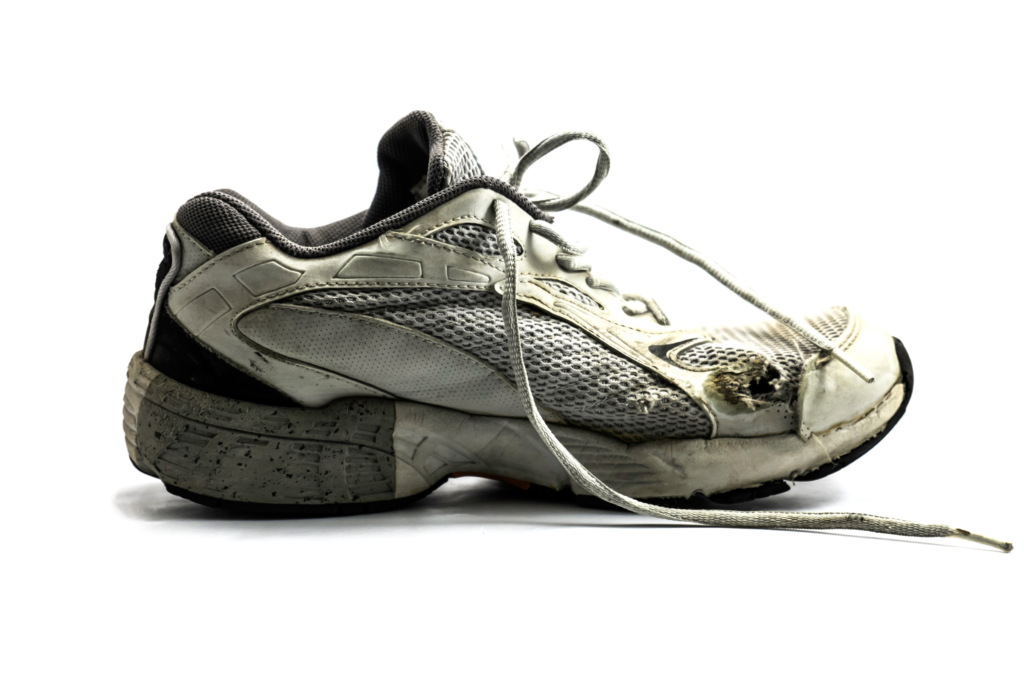Should Running a Mile Be Hard? (9 Tips to Run a Mile Without Stopping or Getting Tired)
Running isn’t for the faint of heart. It’s a grueling challenge that many people take on for its numerous health benefits.
If running was as easy as picking up a pair of tennis shoes, lacing them up, and hitting the road, everybody would do it! Unfortunately, it’s not that simple.
Anybody can go run, but many runners will be met with a rude awakening. Should running a mile be hard, or is it simply that they are out of shape?
Running a mile is hard if you are a beginner runner, overweight, using the wrong footwear, running during the heat of the day, running fasted, struggling with sleep quality, using bad running form, running too fast, or approaching running with the wrong mindset. Working through these obstacles will make running a mile easier!
Read on to learn why running a mile is so challenging and how to make running a mile effortless!
Should running a mile be hard?
Yes, running a mile can be hard!
It is a formidable challenge that requires cardiovascular fitness and considerable muscular endurance. Running a mile can be even more challenging when external factors negatively affect runners; luckily, there are actionable tips that runners can take to improve their running experience and performance.
Runners expecting to lace up their new running shoes and go out for a nice, long run are most likely to be sorely mistaken. Running is very demanding on the body.

Running requires an efficient cardiovascular system, and it takes muscles with endurance and strong tendons and joints to bear the brunt of the impact.
Couple this with external factors that make running challenging, and it’s no wonder that even for great runners, running a mile can be tough!
Bonus Question: Should the average person be able to run a mile?
An average person that is generally in shape and exercises in some way regularly should be able to run a mile. People that are out of shape or have neglected cardiovascular exercise for a long time might find it difficult to run a mile without stopping!
The following are some reasons why running may be challenging for you. If running a mile is hard, don’t worry: it’s completely normal.
- You’re a beginner runner
- Overweight
- Improper footwear/athletic wear
- Running during the heat of day
- Running fasted
- Low sleep quality
- Poor running form
- Aggressive pacing
- Mentality issues
You’re a beginner runner
Running is a sport that takes time. The best runners in the world have spent years upon years building their aerobic base and training for races. What makes you think you can skip the hard work?
Running a mile is more challenging as a beginner if you haven’t run before. Many of the best runners in the world take decades to develop their running capacity; to run a mile will take a small fraction of that, but the principle holds the same.
Running is a sport in itself; the carryover from other sports isn’t super strong.
Even for athletes of other sports, running a mile can be a real challenge because they haven’t ran before. You have to train to run a mile if you want to run a mile, the same way a football player practices plays to later execute in a game.
If you aren’t an athlete or haven’t been for a while, chances are your athletic prowess has withered away. If you don’t use it, you lose it!
However, with time, runners can train their cardiovascular system and improve daily. In fact, the best marathon runners are usually considered middle-aged!
Just be patient and appreciate the process of working hard to achieve your goals.
Overweight
Running is often a formidable challenge for overweight folks. This can stem from an array of factors.
Running a mile is more challenging as an overweight individual due to lifestyle factors and physiological disadvantages.
The reason overweight runners may have a harder time running a mile is two-fold.
The first part is that overweight runners most likely became overweight through unhealthy lifestyle choices. This includes things like lack of exercise, poor nutritional intake, and possibly lack of sleep.
Running is way harder without prior exercise, a healthy diet, and adequate rest!
Running a mile is also harder for overweight individuals because they physically have to exert more energy to account for the extra weight they must move. The muscles, tendons, joints, and heart must all work harder than in a runner who is a healthy weight or even underweight, as many elite runners are.

Improper footwear or athletic wear
Running shoes are specifically designed for running. Regular athletic shoes or everyday casual shoes can’t provide anywhere near the same support and performance boost.
Wearing improper footwear when running a mile will make the task at hand even harder. Running shoes are designed with comfort and ergonomic efficiency in mind, whereas regular shoes are not designed to be run in.
Running shoes are expensive but absolutely worth the investment. Running a mile in proper shoes is much easier than running a mile in casual tennis shoes.
The reasoning is as follows: running shoes are designed to be run in. They provide support for all different types of foot arches, the materials are lightweight and breathable, and they are meant to give runners a great return on the energy they expend.
The opposite of this? Shoes that are hot, heavy, and waste your energy. Buy running shoes and avoid this complication entirely.

Running in extreme heat
Ideal running weather is about 50 degrees Fahrenheit; this is the perfect temperature to warm up quickly and easily regulate body temperature while running.
Any deviations from this make running harder.
Running when it’s hot outside, whether in the summer or the middle of the day, increases the difficulty of running a mile. Runners experience fatigue much quicker when temperatures are higher, and therefore run slower.
Studies show that for every 9-degree increase in temperature, runners slow down substantially. From 41 degrees to 77 degrees, elite runners are 4.5% slower!
Imagine this effect on a beginner runner who lacks a proper aerobic base. Running a mile would be way more challenging!
While it’s impossible to avoid running during the summer unless you take a hiatus or resign yourself to the treadmill, try and run in the morning or at night. The weather should be more temperate and therefore running will be easier.

Running fasted
While it may be unwise to eat a big, greasy meal before running a mile or two, it’s great to fuel up. Running without any food in your system can be tough if you aren’t used to it.
Running fasted, or without having had anything to eat, can make running a mile much more challenging. Food is fuel, and runners will struggle to keep pace and finish their mile without sufficient fuel.
The most prevalent studies inspecting how fasting and running interact revolve around Ramadan, the Islamic holiday where Muslims cannot eat during the day.
The research is not surprising: endurance runners suffer a decline in performance. This is because runners who have not eaten are placed in a glycogen-depleted state.
That is, they have no immediate sugars to utilize for energy. However, it seems that different runners react differently to this. Personally, I run best about 2-2.5 hours after a small, carb-heavy meal in the morning.
Some runners prefer running without glycogen loading to avoid eventually hitting “the wall.” Ultimately, you must figure out what works best for you and your body.

Low sleep quality
Sleep is absolutely crucial. Its role in developing a well-rounded, healthy lifestyle cannot be understated. But, sleep is also how to prepare for a mile run the night before!
Running after experiencing a bad night of sleep, or little sleep, will negatively affect running performance.
A paper published in 2007 by Liverpool University found that athletes who competed on little to no sleep experienced more errors, worse decision-making, and early onset fatigue.
Runners who fatigue quickly are much more susceptible to experiencing challenges completing a mile-long run.
Sleep quality affects more than running; a lack of sleep is detrimental to just about every aspect of life.
Aim for seven to eight hours of high-quality sleep every night to achieve a mile-long run and your general health. This means developing good sleep hygiene practices as well.
Poor running form
Elite runners work on their running form to increase their ergonomic efficiency, translating to faster run times or less energy expenditure. I would recommend basic runners do the same.
Poor running form can make running a mile harder because energy is wasted. Energy is lost in unnecessary motion when the body is not moving in unison. Examples may be swinging the arms too high or striding too long. Additionally, poor running form has a tendency to cause injuries in runners.
Runners with poor form must expend more energy to keep pace with a runner who maintains good form throughout the course of a workout. As the distance gets longer, this effect is compounded.
Running economy is how much energy runners use to maintain a certain pace; poor form has a substantial negative impact on economy.
Runners who then fix their form will not only be able to run a mile easier, but they will also be saving themselves from imminent injury.
Running with poor form is asking for trouble. Running impacts the body; muscles, tendons, and joints are left exposed without proper support and form.
Aggressive pacing
Simply put, aggressive pacing is unwise. Runners who go out too quickly burn themselves out and have great difficulty sustaining their running pace.
Runners who attempt to run at an aggressive pace will have difficulty running a mile if they are not properly trained to maintain their pace.
I’ve seen it many times before; runners start races shooting out of the gates and within the first half mile, they have fizzled out and reduced themselves to walking for the rest of the race. It’s a recipe for disaster.
Running too fast not only makes running a mile more challenging, but it’s hardly beneficial. In reality, most runs should be done at an easy, almost effortless pace.
Set your ego aside momentarily and run slowly. Focus on timing your breathing with your stride and be reasonable with the pace you set out to maintain.
Running a mile is much easier if completed at a sustainable pace!
Mentality issues
Running is more than a physical challenge; it’s mental too.
Many runners find running a mile to be hard because they don’t have a good mentality. As runners, our perceptions are often skewed, and we can do much more than we think.
One of my favorite sayings comes from David Goggins, a former Navy SEAL, and elite ultramarathon runner. He says,
“When your mind first tells you that you are done, that you are tired, and that you cannot go ahead and carry on, you are, in fact, only 40% done.”
David Goggins
I love this quote because it embodies the problem that we have with our mentalities. We are capable of so much, and yet we sell ourselves short.
When you think you’re done, whether in running one mile or fifty, you’re only getting started. Push yourself and achieve more than you set out to.
Is it normal that running a mile is hard for me?
Runner’s high is one of the most gratifying feelings in the world. Unfortunately, it’s not always so pleasurable.
Logging a mile can be difficult for many beginners and experienced runners alike. In fact, it’s perfectly normal!
It’s entirely normal that running a mile is challenging. Running is very demanding of the body, as it requires muscular endurance and proper cardiovascular fitness to complete a run in good shape.
As with most situations, good things don’t come easily. Running has many physical and mental benefits, but runners must earn them through hard work.
Running should be hard, so it’s not out of the ordinary to struggle with running a mile when you’re just getting started. I’ve been running for a couple of years consistently, and I still struggle from time to time.
Running is challenging for a couple of different reasons. On one front, running challenges you physically. To complete a mile or more, runners must have muscular endurance and sufficient cardiovascular fitness.
On another front, running is challenging mentally. The mental challenge of running is a double-edged sword; when you think you want to quit, it’s extremely hard, but it can also be super rewarding to push through the pain and break down that mental barricade.
Although running is tough, keep on pushing, and you’ll prevail, equipped with newfound fitness and mental fortitude!
How long before running a mile gets easier?
Running a mile seems like this big, unapproachable wall for new runners. How will I ever overcome it? How long before I can complete a mile with relative ease?
Running a mile will get easier within the first two to three months. While the time varies based on prior conditioning and exercise habits, this is generally how long it will take for new runners to run a mile with relative ease.
For new runners, their bodies have a hard time adapting to the high-impact nature of the sport.
For starters, runners use substantial quantities of oxygen compared to everyday life, and the cardiovascular system must be properly trained to accommodate this workload.
On top of that, running takes muscular endurance. Every step or stride you take when running activates hundreds of muscles in the body. Your legs propel you, and your upper body stabilizes during the run.
Just as with any form of exercise, the body must be allotted time to adapt. Two to three months is plenty sufficient; many runners will be able to tackle a mile in half of that!
Tips for running a mile without stopping
Running a mile is tough, even for the most elite runners. Luckily, there are ways to overcome the possible challenges of running a mile and learn how to run a mile without stopping.
Many fixes are easy; something such as wearing the wrong shoes can be fixed with a simple change in footwear or clothing.
Other fixes may be more timely; building up an aerobic base by alternating running and walking is highly effective, but it’s a process and runners must practice patience.
Remember, slow and steady wins the race. Also remember that running a mile without stopping is a sign of good progress and overall athletic improvement!
Before you can learn how to run a mile in 8 minutes or even how to run a mile in 9 minutes you have to learn how to run a mile in the first place!
Here are eight wonderful tips for making running a mile easier and more enjoyable!
- Alternate running and walking
- Run with a friend
- Listen to your favorite music or podcast
- Wear breathable clothing
- Be patient
- Mix in strength-training
- Find your breathing pattern
- Switch up your running routes
Alternate running and walking
If you can’t run a mile in one go, there’s no shame in walking what you can’t run!
Alternate running and walking to build an aerobic base efficiently. The strategy was popularized by former Olympic runner Jeff Galloway.
Oftentimes, the problem for beginner runners is their low level of cardiovascular fitness. In other words, their aerobic base is lacking.
While alternating running and walking isn’t glamorous, it is a surefire way to improve your fitness levels and progress up to running a mile consecutively. Run/walk frequently enough, and you’ll find a mile getting easier and easier!
The basis of the run/walk method actually comes from former Olympian Jeff Galloway. He touts it as the best way for beginner runners to build their endurance and assimilate into the sport. You can read more about it in his comprehensive guide to running!
Try running a mile a day
Even if you aren’t quite ready to run a full mile without stopping, nothing will stop you from running a complete mile every day at a slower pace, even stopping for breaks or walking for a while.
By getting out on the road every day, you’ll accelerate your progress!
Run with a friend
A key component of running is consistency, and a lack of motivation often makes it difficult to hit the road. Combat this by finding a running buddy for accountability and enjoyment.
Running with a friend offers multiple benefits. By having a running buddy, runners having difficulty can be held accountable to running while simultaneously encouraging each other. Additionally, running with a friend makes running much more fun.
The golden rule of running is that 80% of your runs should be at an easy, conversational pace; you should be able to hold a conversation while running.
What better than to actually have a conversation? Enter a running buddy.
Running with a friend is the same as going to the gym with a friend; it’s accountability and enjoyment all in one. They will ensure you follow your training, and it’s fun to have someone to talk to during the sometimes monotonous act of running.
If your friends are lame and don’t want to run with you, consider joining a local running group! Local running groups are great for meeting like-minded runners and cultivating new friendships.

Listen to your favorite music or podcast
One of my favorite things to do while running is listen to music or a podcast!
Listening to music or a podcast while running helps take your mind off the activity at hand. Instead of actively thinking about the pain of running, runners can enjoy music or absorb information through podcasts.
I think running with music or a podcast is absolutely non-negotiable. Without my Airpods and my running playlist, I don’t know if life could go on!
All jokes aside, music is scientifically proven to boost running performance. If you want to get fancy, many elite runners will build playlists that match their music’s BPM (beats per minute) to their running pace.
If music isn’t your thing, podcasts or audiobooks are also viable options. While they may not provide rhythm as music does, they are highly informational and help distract runners from the pain they must endure.
Ultimately, listening to anything, whether that be music or podcasts, helps keep runners preoccupied and not thinking about their current struggles.
Personally, I love to go on long easy runs with a nice history podcast playing. One of my favorites is Dan Carlin’s Hardcore History!
Wear breathable clothing
Wearing the wrong clothing for running is almost as bad as wearing improper footwear, just slightly less painful. Take note and make changes accordingly.
Wearing clothing that is suitable for running is not only comfortable but has proven to improve performance. Wearing improper running clothing can cause the body to overheat, leading runners to expend more energy than necessary.
Instead of running in clothing that will make you sweaty like wool and cotton, opt for breathable clothing like Nike’s DriFit line.
Just about any outdoor activity brand carries dri-fit clothing that is meant for exercising; essentially, the clothing wicks away your sweat and allows the body to cool off to avoid overheating easily.
The difference between overheating and cooling off is substantial; running in warmer temperatures necessitates higher energy expenditure than when properly regulating body temperature.
Be patient
Lots of people I know expect running to be an overnight success; this could not be further from the truth. To become proficient at running, you must exercise patience and slowly build your aerobic base.
Runners should be patient with themselves and slowly increase their workload to make running a mile easier.
Patience is a virtue, one especially valuable in the world of running.
Many marathon runners are actually in their 30s or 40s, although most people would expect elite runners to be young and energetic. The trick is that older marathon runners have more years under their belt.
Slowly but surely, your aerobic base compounds over time and it eventually becomes extremely proficient.
Just because a mile is hard now doesn’t mean it will be in a week from now, a month from now, or even a year from now. Be patient and utilize our other tips to make running a mile easier along the way.
Mix in strength-training
A large component of running is muscular endurance. Runners should be sure not to neglect this portion of their training; it can be all too easy to forget to lift weights.
Runners should cross-train through strength training or weight lifting to build their muscular endurance. Oftentimes, athletes are held back by their muscles instead of their cardiovascular fitness. Strength training sets that issue straight.
If your legs start to feel heavy while running a mile, chances are that your muscular endurance isn’t up to par with the rest of your body.
Enter weight-lifting or any other form of resistance training to build strength.
It’s important to have a game plan going into the gym; do you want to build strength, have big muscles, or increase your endurance? Every workout looks different throughout this individualized process.
I recommend lifting two times a week on days you aren’t running. High reps will ultimately be better for building muscular endurance because the muscles will be placed under strain for a prolonged period of time.
However, if you enjoy working out for hypertrophy or strength, go for it! The best exercise is an enjoyable exercise.
Find your breathing pattern
There is absolutely something to be said about finding a rhythm when running. Coming out of the gates is often rough because runners have yet to find their rhythm and they feel out of whack.
Runners can make running a mile easier by matching their breathing pattern with their foot strikes.
New runners typically neglect the importance of establishing a consistent breathing pattern. There are multiple benefits as to why runners should attempt to adopt a breathing pattern as soon as possible.
Among the main reasons are that runners who time their breathing pattern correctly are more efficient as well as better at pacing.
Runners who time their breathing are more efficient because they inhale and exhale when the core and diaphragm is properly stabilized. Without rhythmic breathing, runners will lose breath from the high impact of their foot striking the ground.
Here is a nice video with quick, actionable tips for improving your breathing while running – courtesy of The Run Experience:
Switch up your running routes
To make running more enjoyable, consider running different routes than usual to avoid boredom with the local sights.
Running different routes makes running easier and more enjoyable due to variety. By running different routes, runners can see new sights and challenge themselves with possible terrain or elevation changes they may not usually run.
Running new routes is beneficial from both a training and enjoyment standpoint.
Running around the same neighborhood day after day becomes monotonous; vary the routes you run to keep things fresh and exciting. Get lost and find your way back if you’re the adventurous type!
Also a benefit of changing your running route, it offers an opportunity to expose your body to new training stimuli. Different routes may be on different surfaces or subject to elevation change.
If you find yourself bored and looking for a new challenge, put yourself out there and run a new route!
Celebrate your running a mile day!
Once you’ve made it across the finish line, so to speak, don’t forget to congratulate yourself and treat yourself to a little reward.
Personally, I like a beer after a run – especially a PR run!






